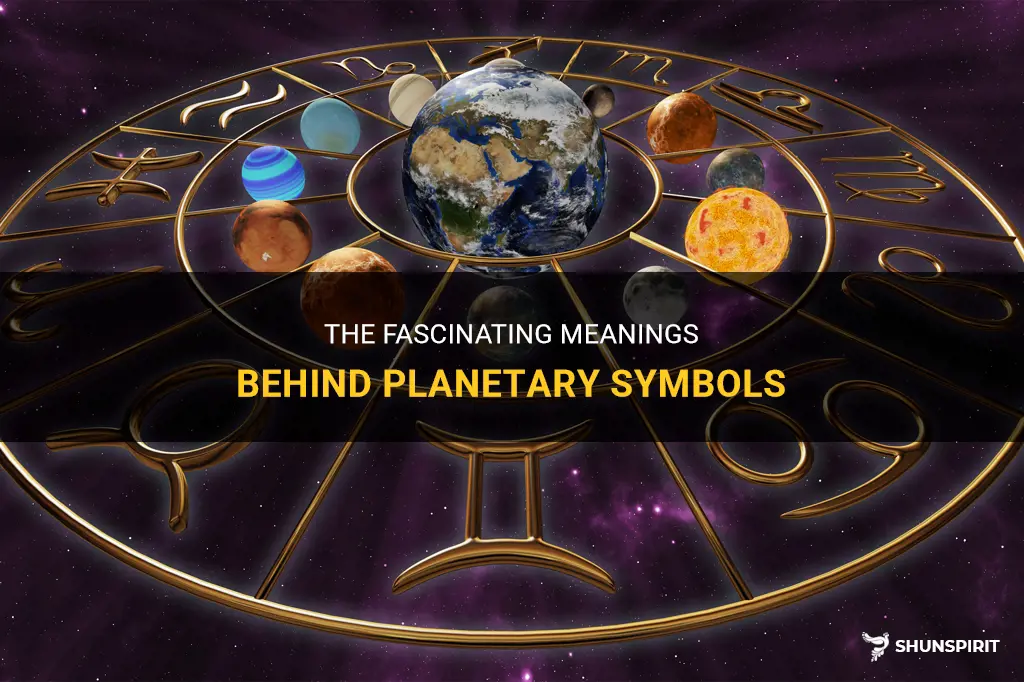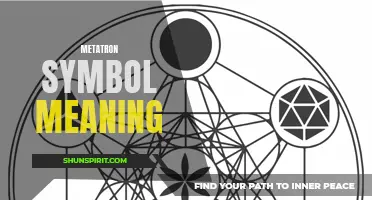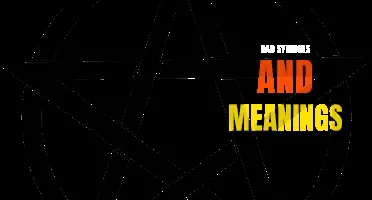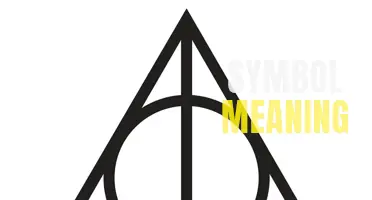
Planet symbols are intriguing and rich in meaning. They are powerful representations of celestial bodies that have captured the imagination of humans for centuries. Each symbol is carefully crafted to encapsulate the unique qualities and attributes associated with its corresponding planet. From the fiery symbol of Mars to the ethereal symbol of Neptune, these ancient symbols tell a fascinating story about the planets they represent. Join us on a journey through the universe as we explore the meanings behind these captivating planet symbols.
What You'll Learn
- What are the symbols used to represent each planet in astrology and what do they mean?
- How do the symbols for the planets differ in Western astrology versus Vedic astrology?
- Are there any historical or cultural influences on the development of the planet symbols and their meanings?
- How do astrologers interpret the placement and aspects of the planet symbols in a birth chart?
- Are there any modern interpretations or variations of the traditional planet symbols and meanings?

What are the symbols used to represent each planet in astrology and what do they mean?
In astrology, each planet is associated with specific symbols that represent their energies and characteristics. These symbols, also known as glyphs, are a visual representation of the planet's essence and are used in astrology charts and horoscopes.
- The Sun: The symbol for the Sun is a circle with a dot at the center. It represents the core self, individuality, vitality, and creative energy. The Sun is often considered the most important planet in astrology, as it symbolizes the ego and the life force.
- The Moon: The symbol for the Moon is a crescent shape that resembles a half-moon. It represents emotions, intuition, and the subconscious mind. The Moon is associated with nurturing, motherhood, and the receptive side of our personality.
- Mercury: The symbol for Mercury is a circle with a crescent on top, resembling a stylized "H." It represents communication, intellect, and quick thinking. Mercury is associated with logic, analysis, and the way we process information.
- Venus: The symbol for Venus is a circle with a cross below it, symbolizing femininity and beauty. It represents love, relationships, pleasure, and the way we express affection. Venus is associated with harmony, aesthetics, and attraction.
- Mars: The symbol for Mars is a circle with an arrow pointing upwards. It represents energy, action, and assertiveness. Mars is associated with passion, desire, and the way we assert ourselves in the world.
- Jupiter: The symbol for Jupiter is a crescent with a vertical line crossing it. It represents expansion, growth, and abundance. Jupiter is associated with wisdom, luck, and the way we seek meaning and purpose in life.
- Saturn: The symbol for Saturn is a cross with a curved line crossing it at the top. It represents discipline, responsibility, and structure. Saturn is associated with hard work, limitations, and the way we build long-lasting foundations.
- Uranus: The symbol for Uranus is a circle with a horizontal line attached to it, resembling a bullseye. It represents change, innovation, and individuality. Uranus is associated with originality, rebellion, and the way we break free from societal norms.
- Neptune: The symbol for Neptune is a trident, resembling a three-pronged spear. It represents spirituality, intuition, and the subconscious mind. Neptune is associated with dreams, illusions, and the way we connect to the divine.
- Pluto: The symbol for Pluto is a circle with a horizontal line below it, resembling a cross seen in Christianity. It represents transformation, power, and deep truths. Pluto is associated with the subconscious, regeneration, and the way we face and overcome our fears.
These symbols provide a visual shorthand for astrologers to quickly identify and interpret the planetary energies within a birth chart or horoscope. They allow astrologers and enthusiasts to understand the various influences and dynamics at play in an individual's life, offering insights into personality traits, life experiences, and potential future events.
The Symbolism and Meanings Behind the Four Evangelists: Unveiling the Secrets of Their Icons
You may want to see also

How do the symbols for the planets differ in Western astrology versus Vedic astrology?
In both Western astrology and Vedic astrology, the planets are of great significance. They play a crucial role in determining an individual's personality traits, character, and life events. However, the symbols used to represent the planets differ between these two astrological systems.
In Western astrology, the symbols for the planets are derived from the symbols of the Roman gods after which the planets are named. For example, the symbol for Mercury is a circle with a cross at the bottom, which represents the winged helmet of the Roman god Mercury. Similarly, the symbol for Venus is a circle with a small cross underneath, symbolizing the hand mirror of the Roman goddess Venus.
In contrast, Vedic astrology uses a different set of symbols to represent the planets. The symbols are primarily geometric shapes that are believed to be more aligned with the esoteric teachings of ancient Indian astrology. For example, the symbol for Mercury in Vedic astrology is a crescent moon with a circle on top, representing the mind and intellect. The symbol for Venus is a circle with a cross at the bottom, similar to the Western astrology symbol, but with a different interpretation.
The differences in the symbols used for the planets in Western astrology versus Vedic astrology may seem purely aesthetic, but they can also reflect deeper philosophical and cultural distinctions between the two traditions. Western astrology is rooted in Greco-Roman mythology, while Vedic astrology is influenced by Hindu philosophy and symbolism.
Despite the divergent symbols, the fundamental meanings and interpretations of the planets remain fairly consistent between Western and Vedic astrology. For example, both astrological systems recognize the Sun as a symbol of vitality, power, and individuality, regardless of the symbol used to represent it.
It's important to note that while the symbols for the planets may differ, the principles and techniques used to interpret their influence in an individual's birth chart are similar in both Western and Vedic astrology. Both systems consider the position, aspects, and relationships of the planets at the time of an individual's birth to provide insights into their personality, career, relationships, and life events.
In conclusion, Western astrology and Vedic astrology use different symbols to represent the planets. Western astrology uses symbols derived from Roman mythology, while Vedic astrology uses geometric shapes aligned with ancient Indian astrology. Despite the differences in symbols, the fundamental meanings and interpretations of the planets remain consistent between the two systems. Both Western and Vedic astrology offer valuable insights into an individual's life based on the position and relationships of the planets at the time of their birth.
The Mysterious and Intriguing Meaning Behind the Blue Eye Symbol
You may want to see also

Are there any historical or cultural influences on the development of the planet symbols and their meanings?
The use of symbols to represent the planets in our solar system can be traced back to ancient civilizations. Throughout history, different cultures have assigned symbols to represent the various celestial bodies in our sky. These symbols often reflect the cultural values and beliefs of the societies in which they originated.
One of the earliest known examples of planet symbols comes from ancient Mesopotamia. The symbols used by the Babylonians to represent the seven celestial bodies known at the time, including the Sun and Moon, have been found on clay tablets dating back to around 3000 BCE. These symbols were closely associated with astrology and were used in the practice of divination.
The Greeks also had their own set of symbols for the planets, which were later adopted by the Romans. These symbols were based on the names of the planets, which were derived from Greek and Roman mythology. For example, the symbol for Venus is derived from the goddess Aphrodite, while the symbol for Mars is based on the god of war.
In addition to these ancient civilizations, other cultures around the world have their own unique symbols for the planets. In Chinese astrology, for example, each planet is associated with a different animal. The Chinese zodiac includes symbols for the Sun, Moon, and the five visible planets.
The development of these symbols and their meanings was influenced by a variety of factors, including religious beliefs, astrology, and the observation of celestial phenomena. In many cases, the symbols were also influenced by the physical characteristics of the planets themselves. For example, the symbol for Mercury is based on the caduceus, a staff with two snakes wrapped around it, which is associated with the messenger of the gods.
The meanings of these symbols can vary depending on the cultural context in which they are used. In astrology, for example, the symbols are often associated with specific personality traits and characteristics. The symbol for Venus, for instance, is often associated with love and beauty, while the symbol for Mars is associated with assertiveness and aggression.
In conclusion, the development of planet symbols and their meanings is influenced by a combination of historical and cultural factors. These symbols reflect the beliefs, values, and observations of ancient civilizations and continue to be used today in various contexts, including astrology and astronomy. Understanding the historical and cultural influences on these symbols can provide valuable insights into the ways in which different societies have interpreted and understood the celestial bodies in our sky.
The Symbolic Meaning and Significance of the Fujitsu Logo
You may want to see also

How do astrologers interpret the placement and aspects of the planet symbols in a birth chart?
Astrologers interpret the placement and aspects of the planet symbols in a birth chart by analyzing their individual characteristics and how they interact with each other. Each planet symbol is believed to represent a different aspect of our personality and life experiences, and its placement in the birth chart can provide insights into various areas of one's life.
The birth chart, also known as the natal chart, is a map of the sky at the time of an individual's birth. It is divided into twelve houses, each representing different areas of life such as relationships, career, and spirituality. The precise placement of the planets within these houses, as well as the angles they form with each other, reveal valuable information about a person's personality, talents, strengths, and potential challenges they may face.
Astrologers interpret the placement of each planet symbol by considering its zodiac sign and the house it is located in. The zodiac sign determines the general characteristics of the planet, while the house indicates the specific area of life that the planet's energy will influence.
For example, if a person has Mars in the zodiac sign of Aries in the 10th house, an astrologer would analyze the aggressive and assertive qualities associated with Mars in Aries and how it may manifest in the person's career or public image. This placement could suggest a strong drive for success and leadership qualities in the person's professional life.
In addition to the placement, astrologers also consider the aspects between the planet symbols. Aspects are the angles formed between two or more planets, and they reveal the dynamic relationships and influences between them. The most commonly analyzed aspects include the conjunction, opposition, square, trine, and sextile.
For instance, if Mercury, the planet symbolizing communication, forms a trine aspect with Venus, the planet symbolizing love and relationships, it suggests that the person has a natural ability to express their feelings and connect with others in a harmonious and diplomatic way.
Astrologers analyze the aspects by considering the energies and qualities of the planets involved. A harmonious aspect, such as a trine or sextile, indicates a flow of energy between the planets, resulting in positive interactions and ease in expressing their qualities. On the other hand, a challenging aspect, such as a square or opposition, suggests tension and potential conflicts between the planets involved.
By analyzing the placement and aspects of the planet symbols in a birth chart, astrologers can provide valuable insights and guidance on various aspects of an individual's life, including personality traits, career potential, relationships, and life experiences. This interpretation allows individuals to better understand themselves, navigate challenges, and make informed decisions aligned with their unique astrological makeup.
Unlocking the Secrets: Unveiling the Hidden Meanings Behind Love Symbols
You may want to see also

Are there any modern interpretations or variations of the traditional planet symbols and meanings?
The traditional symbols and meanings associated with the planets in our solar system have been used for centuries to represent the various celestial bodies and their corresponding astrological influences. However, with the advent of modern astrology and the advancements in our understanding of the planets and their characteristics, there have been some variations and interpretations of these symbols.
One modern interpretation of the traditional planet symbols can be seen in the work of astrologer Dane Rudhyar. Rudhyar believed that the traditional symbols were limited in their ability to fully represent the complexities of the planets and their influences. As a result, he developed a system of symbols that he believed better captured the essence of each planet.
For example, Rudhyar reimagined the symbol for Mercury as a circle with a crescent and cross inside it. He argued that this symbol better represented the intellectual and communicative nature of the planet. Similarly, he reimagined the symbol for Venus as a circle with a cross underneath, symbolizing the harmonious and relational qualities of the planet.
Another variation in the interpretation of the traditional planet symbols can be found in the work of astrologer Liz Greene. Greene believed that the traditional symbols were too rigid and limited in their ability to fully express the complexities of the planets. As a result, she developed a system of symbols that incorporated elements from various mythologies and spiritual traditions.
For example, Greene reimagined the symbol for Mars as a spear or arrow, symbolizing the planet's warrior-like and assertive nature. She believed that this symbol better captured the dynamic and energetic qualities of Mars. Similarly, she reimagined the symbol for Saturn as a scythe or sickle, symbolizing the planet's disciplinary and transformative influences.
While these modern interpretations and variations of the traditional planet symbols have gained some popularity among certain astrologers and enthusiasts, it is important to note that they are not universally accepted or recognized. Traditional symbols and meanings still remain the most widely used and recognized representations of the planets in astrology.
In conclusion, there have been some modern interpretations and variations of the traditional planet symbols and meanings. Astrologers like Dane Rudhyar and Liz Greene have reimagined the symbols to better capture the complexities and characteristics of the planets. However, it is important to note that these interpretations are not universally accepted and traditional symbols still remain the most widely recognized and used representations in astrology.
A Beginner's Guide to Process Mapping Symbols and Their Meanings
You may want to see also
Frequently asked questions
The symbol for Earth is a circle with a cross in the center. It is often interpreted as representing the four cardinal directions or the four elements - earth, air, fire, and water. It can also symbolize unity and balance between these elements.
The symbol for Mars is a circle with an arrow pointing to the right. It represents the shield and spear of the god of war in ancient Roman mythology, which Mars is associated with. This symbol is also used to represent the male gender.
The symbol for Venus is a circle with a cross underneath it. It is often interpreted as a mirror reflecting beauty, as Venus is the goddess of love and beauty in Roman mythology. This symbol is also used to represent the female gender.







